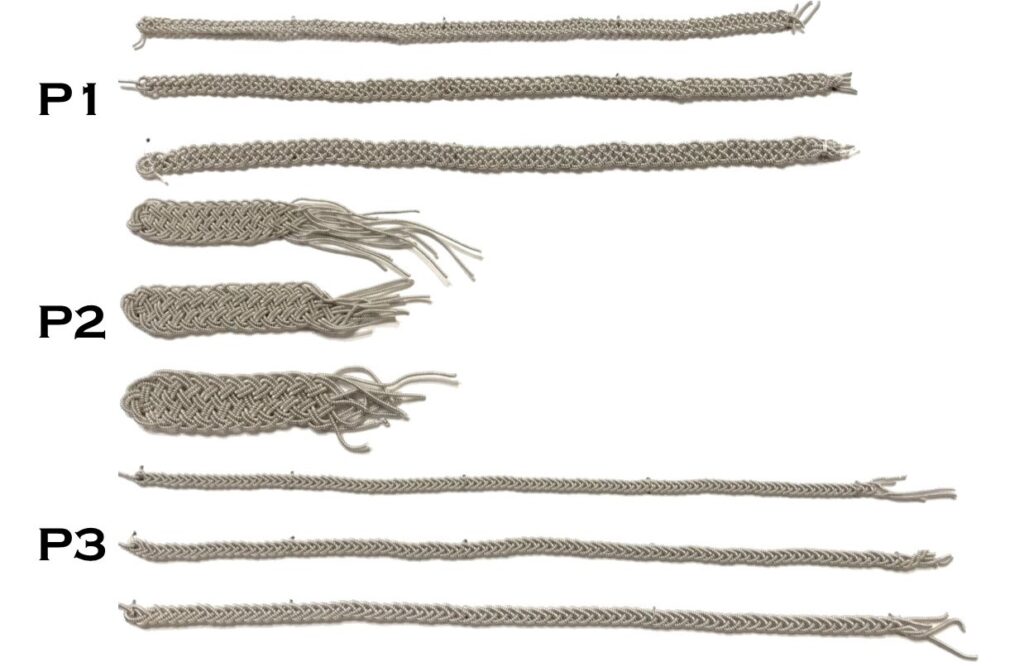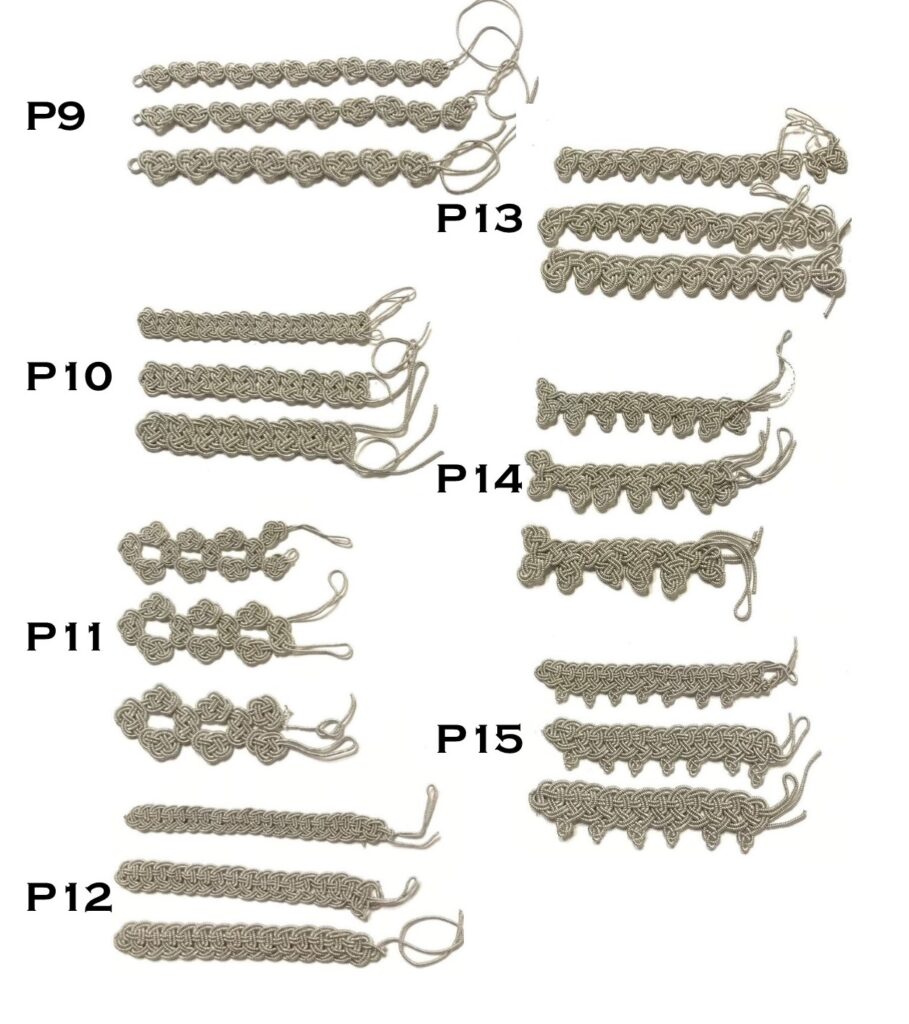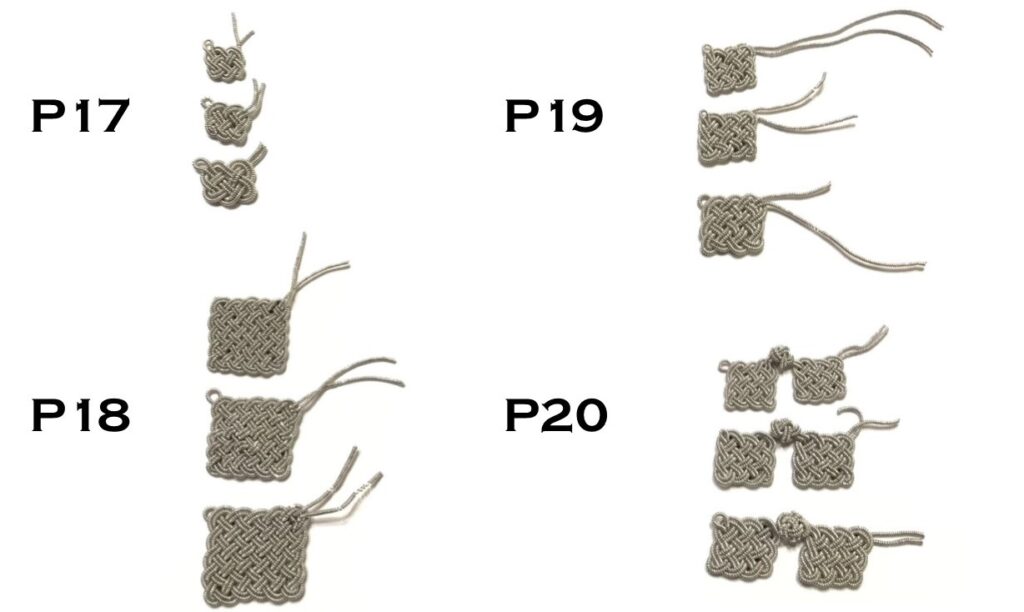How much tenntråd do I need to make that?
How much material is needed to create a particular length or size of posament is one of the most common questions asked in posament reconstruction. Below are experimentally determined ratios for calculating the amounts you will need.
Caveats to the calculations:
- The multiplier works in any unit (centimeters, inches, miles), but the excess recommendation would need to be converted from centimeters. (The automatic calculators ONLY use centimeters.)
- All these experimental example posaments are woven fairly tightly. Variations in weaving density may change the amounts needed. Please refer to the images for an approximation of how tightly to weave the posaments to receive similar results. If you increase/decrease your screen viewing size until the images match the lengths in the table, you will have a good idea of what your final posament will look like.
- Because the line that goes around the outside of each knot takes a little bit more material than the inside line, you need an asymmetric amount for each line on the knots. You may want to start with a little extra on the outside line. The braids are an exception; they should be relatively balanced and can be worked with even lengths.
- These calculations only cover the spiral posaments at present. The drawn wire posaments should be added soon.
- These calculations are based on using the commercially available tenntråd in the 0.25, 0.3, and 0.35 sizes. Results may differ when using other sizes or handmade tenntråd. These sizes were chosen because they most closely match the diameters of spiral wire seen in the Birka examples. However, if one wanted to expand these calculations to other sizes of spiral wire (commercial or handmade), the percent difference calculations from the Posament Reconstructions page could be cautiously used to provide an estimate.
Key to Data Tables:
- Posament number: Number assigned in Birka III for this pattern.
- Tenntråd Size: Gauge of wire used in the experimental example.
- Amount of Tenntråd: Length of wire used to create the experimental example.
- Length: Measured length of the experimental example.
- Height: Measured height of the experimental example.
- Width: Measured width of the experimental example.
- Repeat Size: Average width of one unit of the posament pattern. This does not apply to braids.
- Number of Repeats: Number of posament pattern units in the experimental example. This does not apply to braids.
- Multiplier: Used to calculate the minimum amount of tenntråd needed to produce the desired length of posament. The desired final length is multiplied by this number.
- Excess per Piece: the recommended amount of excess to be added to the total to allow for the length to comfortably knot all desired repeats.
Sample Calculation:
For Braids and Bands:
Tenntråd Required = (relevant Multiplier x desired length) + Excess
Example:
I want to make 20cm of P10 in 0.25 tenntråd.
From the table: P10 with 0.25 tenntråd = 16.7 multiplier and 8cm excess
(Multiplier x desired length) + Excess = (16.7 x 20cm)+8cm = 342cm
Minimum 342cm for this project!
For Spangles, Finials, and Rings:
Tenntråd Required = (relevant Multiplier + Excess) x desired quantity
Example:
I want to make three of P24 in 0.3 tenntråd.
From the table: P24 with 0.3 tenntråd = 23 multiplier and 10cm excess
(Multiplier + Excess) x desired quantity = (23 + 10cm) x 3 = 99 cm
Around 99cm needed for this project!
(Because you make spangles one at a time, not as a continuous item, if you leave the tenntråd in one long piece, the excess can sometimes be reused in subsequent items, so you may end up with some left over. This is generally only a noticeable quantity if you are making either a large number or one of the larger spangles.)
Find the multipliers and the recommended excess from the data tables below!
Braids (P1, P2, and P3)
Bands (P9, P10, P12, P14, and P15)
Spangles (P16, P17, P18, P19, and P20)
Finials (P21 and P22)
Rings (P23, P24, and P26)
Afraid of math? There are automatic calculators at the bottom for
Braids, Bands, Spangles, and Finials and Rings!
Data Tables
Braids
P1, P2, and P3
| Number | Tenntråd Size | Amount of Tenntråd (cm) | Length (cm) | Height (cm) | Width (cm) | Multiplier | Excess |
| P1 | 0.25 | 100 | 13.2 | 0.3 | N/A | 7.6 | 5 |
| P1 | 0.3 | 100 | 13.7 | 0.4 | N/A | 7.3 | 5 |
| P1 | 0.35 | 100 | 13.7 | 0.5 | N/A | 7.3 | 5 |
| P2 | 0.25 | 100 | 3.4 | 0.8 | N/A | 29.4 | 7 |
| P2 | 0.3 | 100 | 4 | 0.9 | N/A | 25.0 | 7 |
| P2 | 0.35 | 100 | 4.2 | 1.1 | N/A | 23.8 | 7 |
| P3 | 0.25 | 100 | 14.5 | 0.25 | N/A | 6.9 | 5 |
| P3 | 0.3 | 100 | 15 | 0.3 | N/A | 6.7 | 5 |
| P3 | 0.35 | 100 | 14.5 | 0.4 | N/A | 6.9 | 5 |

Bands
P9, P10, P12, P14, and P15
| Number | Tenntråd Size | Amount of Tenntråd (cm) | Length (cm) | Height (cm) | Repeat Size (cm) | Number of Repeats | Multiplier | Excess |
| P9 | 0.25 | 100 | 8 | 0.6 | 0.7 | 11 | 12.5 | 9 |
| P9 | 0.3 | 100 | 8.5 | 0.7 | 0.8 | 10 | 11.8 | 10 |
| P9 | 0.35 | 100 | 7.7 | 0.8 | 0.9 | 8 | 13.0 | 13 |
| P10 | 0.25 | 100 | 6 | 0.75 | 0.5 | 12 | 16.7 | 8 |
| P10 | 0.3 | 100 | 5.7 | 0.9 | 0.55 | 10 | 17.5 | 10 |
| P10 | 0.35 | 100 | 5.3 | 1 | 0.6 | 8 | 18.9 | 13 |
| P11 | 0.25 | 100 | 4.5 | 1.5 | 1.1 | 4 | 22.2 | 25 |
| P11 | 0.3 | 100 | 4.3 | 1.7 | 1.3 | 3.5 | 23.3 | 29 |
| P11 | 0.35 | 100 | 4.1 | 1.8 | 1.4 | 3 | 24.4 | 33 |
| P12 | 0.25 | 100 | 6.3 | 0.7 | 0.4 | 20 | 15.9 | 5 |
| P12 | 0.3 | 100 | 6.4 | 0.8 | 0.6 | 18 | 15.6 | 6 |
| P12 | 0.35 | 100 | 6.2 | 0.9 | 0.7 | 15 | 16.1 | 7 |
| P13 | 0.25 | 100 | 6.7 | 0.75 | 0.5 | 14 | 14.9 | 7 |
| P13 | 0.3 | 100 | 7 | 0.8 | 0.6 | 12 | 14.3 | 8 |
| P13 | 0.35 | 100 | 7 | 0.9 | 0.6 | 11 | 14.3 | 9 |
| P14 | 0.25 | 100 | 5 | 0.9 | 0.7 | 8 | 20.0 | 13 |
| P14 | 0.3 | 100 | 5 | 1 | 0.8 | 7 | 20.0 | 14 |
| P14 | 0.35 | 100 | 4.8 | 1.1 | 0.9 | 6 | 20.8 | 17 |
| P15 | 0.25 | 100 | 5.5 | 0.9 | 0.75 | 8 | 18.2 | 13 |
| P15 | 0.3 | 100 | 5.5 | 1.2 | 0.9 | 7 | 18.2 | 14 |
| P15 | 0.35 | 100 | 5.5 | 1.3 | 1 | 6.5 | 18.2 | 15 |
P15: the core line is 6% of the overall tenntråd length.
P12 & P15: Repeats overlap, amount of overlap will influence amount of tenntråd needed.

Spangles
P17, P18, P19 and P20
| Number | Tenntråd Size | Amount of Tenntråd (cm) | Height (cm) | Width (cm) | Multiplier | Excess |
| P17 | 0.25 | 12 | 0.6 | 0.8 | 12 | 5 |
| P17 | 0.3 | 13.5 | 0.7 | 0.9 | 13.5 | 5 |
| P17 | 0.35 | 16 | 0.8 | 1.1 | 16 | 6 |
| P18 | 0.25 | 52 | 1.4 | 1.4 | 52 | 21 |
| P18 | 0.3 | 57 | 1.6 | 1.6 | 57 | 23 |
| P18 | 0.35 | 65 | 1.8 | 1.8 | 65 | 26 |
| P19 | 0.25 | 23 | 0.9 | 1 | 23 | 9 |
| P19 | 0.3 | 25 | 0.95 | 1.1 | 25 | 10 |
| P19 | 0.35 | 27 | 1.1 | 1.25 | 27 | 11 |
| P20 | 0.25 | 48 | 0.85 | 1.8 | 48 | 11 |
| P20 | 0.3 | 55 | 1 | 2.5 | 55 | 10 |
| P20 | 0.35 | 62 | 1.1 | 2.8 | 62 | 12 |
P20: Height does not include joining knot, width is measured with the piece laid in a single layer, as displayed.

Finials
P21 and P22
| Number | Tenntråd Size | Amount of Tenntråd (cm) | Height (cm) | Width (cm) | Multiplier | Excess | Tenntråd in each component (cm) |
| P21 | 0.25 | 30 | 0.9 | 0.9 | 30 | 12 | Ring 18, Finial 12 |
| P21 | 0.3 | 36 | 1.2 | 1.3 | 36 | 14 | Ring 22, Finial 14 |
| P21 | 0.35 | 42 | 1.8 | 1.6 | 42 | 17 | Ring 26, Finial 16 |
| P22 | 0.25 | 46 | 1.5 | 1.5 | 46 | 18 | Ring 18, Finial 28 |
| P22 | 0.3 | 50 | 1.7 | 1.7 | 50 | 20 | Ring 21, Finial 29 |
| P22 | 0.35 | 57 | 1.9 | 1.8 | 57 | 23 | Ring 26, Finial 31 |

Rings and Balls
P23, P24, and P26
| Number | Tenntråd Size | Amount of Tenntråd (cm) | Length (cm) | Height (cm) | Width (cm) | Multiplier | Excess |
| P23 | 0.25 | 14 | 0.5 | 0.5 | 0.3 | 14 | 6 |
| P23 | 0.3 | 14 | 0.7 | 0.7 | 0.4 | 14 | 6 |
| P23 | 0.35 | 15 | 0.75 | 0.75 | 0.6 | 15 | 6 |
| P24 | 0.25 | 20 | 0.5 | 0.5 | 0.4 | 20 | 8 |
| P24 | 0.3 | 23 | 0.8 | 0.8 | 0.5 | 23 | 9 |
| P24 | 0.35 | 24 | 1 | 1 | 0.6 | 24 | 10 |
| P26 | 0.25 | 11 | 0.4 | 0.4 | 0.4 | 11 | 4 |
| P26 | 0.3 | 12 | 0.5 | 0.5 | 0.5 | 12 | 5 |
| P26 | 0.35 | 15 | 0.55 | 0.55 | 0.55 | 15 | 6 |

